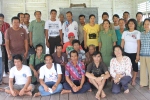,
Manager of the ILO/EIIP GLACIER Project in Central Kalimantan, Indonesia (pictured here with a villager)
Our jeep got stuck in the mud again. Without a word, we all knew what to do next. We got off and started to push. Villagers passing by also got off from their motorbikes to help.
It was the third time we were forced to stop in the last ten-kilometre stretch before reaching Aruk, a small rural village in Central Kalimantan (Borneo Island). We struggled for three hours on the muddy road, but we finally made it.
Aruk is home to the Dayak Ngaju, one of the main indigenous groups in Central Kalimantan. 650 people live in this village of mostly wooden houses built on the margins of the river Kapuas. Children swim and play cheerfully. The air smells of cooked rice and the sweet scent of rambutan, mango and guava trees. This has been my workplace for the past year.
But the first picturesque scene cannot hide the reality of the Dayak. Where they live is surrounded by tropical forests that have suffered an enormous impact from intensive agricultural practices and timber and mining activities.
In fact, the river is highly contaminated, since villagers use mercury to mine for gold.
Logging has degraded the forests, resulting in massive and frequent floods and fires. The extensive use of land for rice production has destroyed much of the original peat lands. The Dayak are aware of this problem.
“If we use forests like this, someday resources will run out and we will not leave any for our grandchildren,” they say.
Then, why continue logging and mining? I get clear answers: “Of course we want to have more sustainable livelihoods, but we do not have an alternative source of income. We don’t have the necessary skills to access the labour market.”
Different government development projects have been implemented in past decades in Central Kalimantan, but they have not reflected the needs of the Dayak.
In 1996, the government of President Suharto cleared 1.4 million hectares of peat land to make way for irrigated rice production and moved in farmers from other parts of Indonesia. It was called the Mega Rice Project and it soon proved to be a major environmental disaster.
But the Indonesian government is now making an effort to regenerate peat lands and forests. In conjunction with that, ILO in Indonesia has developed the GLACIER (Green Livelihood Access in Central Kalimantan for Inclusive Environmental Response to Climate Change), a project run by the ILO’s Employment Intensive Investment Programme in partnership with ILO’s Green Jobs Programme.
- A women in Aruk ready to plant rubber and pineapple
- Participants of a community consultation meeting in Aruk
- Road construction in Aruk
Convention 169 was adopted in 1989 and has been ratified to date by 22 countries. Indonesia is not among them. The Convention calls for special measures to safeguard the persons, institutions, property, labor, cultures and environment of indigenous and tribal peoples.There are more than 370 million self-identified indigenous peoples in some 70 countries. The biggest concentration of indigenous peoples is in Asia and the Pacific – an estimated 70 per cent.
What makes GLACIER different is that it focuses on the real needs of the villagers, and that it involves them in decision-making processes. Our approach is based on the principles outlined in the Indigenous and Tribal Peoples Convention, 1989 (No. 169).
The principles of consultation and participation constitute the cornerstone of the Convention, requiring that indigenous and tribal peoples are consulted on issues that affect them.
Investing in people
The GLACIER project has three components: environment investment through agro and community forestry systems, improvement of roads, trails, bridges and crossings to facilitate rural access, and green value chain development through fishery and rubber production enhancement linked to market activity.
Only if villagers can gain from more sustainable activities will they give up destructive activities such as illegal logging and mining. Only then will it be possible to tackle deforestation.
I have seen that any outside proposal is perceived with scepticism by the villagers. But the ILO’s local resource-based approach has managed to overcome mistrust, and that’s because they have been part of the process at every step. For example, most of the community members – both men and women – were actively involved in the construction and plantation works.
To prevent forest fires and contribute to peat land rehabilitation, they are planting local species with high economic value, such as rubber, galam, jelutung, rambutan and durian.
To enhance access to regional markets, we are improving the quality of a motorbike trail, a swampy crossing and a bridge as part of a pilot project to be adopted and replicated by other parties, in particular relevant government agencies. We are also carrying out entrepreneurship training and developing skills to improve the quality and quantity of rubber and fish production, as well as building partnerships with the private sector.
No surprise people are becoming enthusiastic.
As GLACIER is coming to an end, my stay in Central Kalimantan will soon finish. Working over this past year with the Dayak Ngaju has been a rewarding challenge.
It has also reaffirmed my view that indigenous peoples in Central Kalimantan are finally being taken into account. The ILO’s Convention 169 has been crucial in this process. This is something we should all bear in mind as we mark the International Day of the World’s Indigenous Peoples on August 9th.





Good job Gah, I knew you could do it
Thanks pak Marcel.